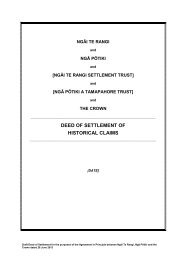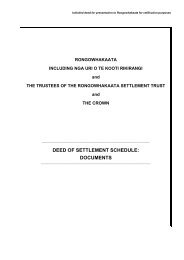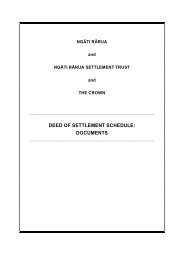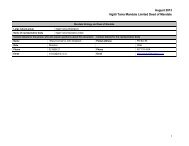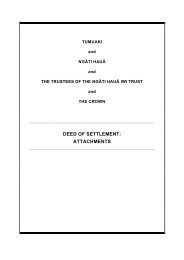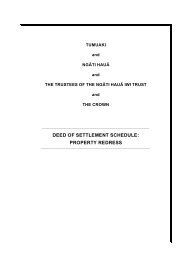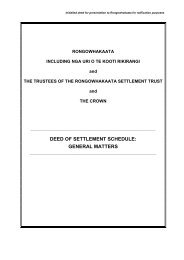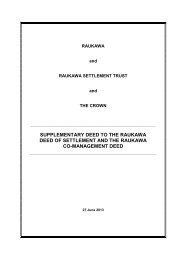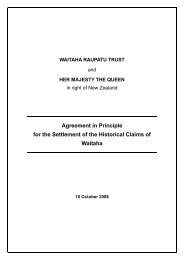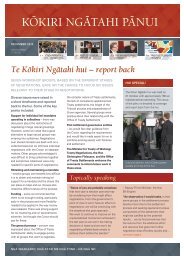Ngati Haua Deed of Settlement - Terabyte Interactive
Ngati Haua Deed of Settlement - Terabyte Interactive
Ngati Haua Deed of Settlement - Terabyte Interactive
You also want an ePaper? Increase the reach of your titles
YUMPU automatically turns print PDFs into web optimized ePapers that Google loves.
NGĀTI HAUĀ DEED OF SETTLEMENT3: ACKNOWLEDGEMENT AND APOLOGY3.4.4 that as part <strong>of</strong> its military operations during the Waikato war, Crown forcesoccupied land in the Ngāti Hauā rohe including sites <strong>of</strong> significance to NgātiHauā;3.4.5 that Ngāti Hauā suffered significant economic loss and social disruption whenit left its homes and cultivations in the aftermath <strong>of</strong> the Crown’s confiscation <strong>of</strong>Waikato land in 1864; and3.4.6 the sense <strong>of</strong> grievance suffered and the distress caused to generations <strong>of</strong>Ngāti Hauā who felt the iwi and its leaders, including Wiremu Tamehana, wereunfairly considered to be rebels during the 1860s.3.5 The Crown has previously recognised that the Kīngitanga continued to sustain thepeople since the Raupatu, and its leaders have petitioned the Crown for justice and forthe return <strong>of</strong> land since 1865. The Crown particularly acknowledges the despair andfrustration it caused Wiremu Tamehana and Ngāti Hauā because it did not agree toTamehana’s requests to establish an inquiry into the causes <strong>of</strong> the war and to return toNgāti Hauā all <strong>of</strong> the lands it had confiscated.3.6 The Crown acknowledges that -3.6.1 it did not consult Ngāti Hauā about the introduction <strong>of</strong> the native land laws;3.6.2 the resulting individualisation <strong>of</strong> land tenure was inconsistent with Ngāti Hauātikanga; and3.6.3 the operation and impact <strong>of</strong> the native land laws, in particular the award <strong>of</strong>land to individual Ngāti Hauā and the enabling <strong>of</strong> individuals to deal with thatland without reference to iwi or hapū, made those lands more susceptible topartition, fragmentation and alienation. This undermined the traditional tribalstructures, mana and rangatiratanga <strong>of</strong> Ngāti Hauā, which were based oncollective tribal and hapū custodianship <strong>of</strong> the land. The Crown failed toprotect those collective tribal structures, which had a prejudicial effect onNgāti Hauā and was a breach <strong>of</strong> Te Tiriti o Waitangi / the Treaty <strong>of</strong> Waitangiand its principles.3.7 The Crown acknowledges that -3.7.1 between 1866 and 1873 Ngāti Hauā were awarded interests in several landblocks in the names <strong>of</strong> only ten owners who were able to act as absoluteowners, rather than for or on behalf <strong>of</strong> Ngāti Hauā;3.7.2 by 1884 some owners <strong>of</strong> Matamata, Puketutu and Hinuera 1 sold theirinterests against the wishes <strong>of</strong> the other owners; and3.7.3 by allowing these individuals to sell Ngāti Hauā land in these blocks, thenative land legislation did not reflect the Crown’s obligation to actively protectthe interests <strong>of</strong> Ngāti Hauā in these blocks, and this was a breach <strong>of</strong> Te Tiriti oWaitangi / the Treaty <strong>of</strong> Waitangi and its principles.3.8 The Crown acknowledges that, in purchasing over 1,400 acres <strong>of</strong> Matamata Northbetween 1918 and 1930 from individuals, it disregarded the collective decision <strong>of</strong> theNgāti Hauā owners not to sell their land, and this was a breach <strong>of</strong> Te Tiriti o Waitangi /the Treaty <strong>of</strong> Waitangi and its principles.34



